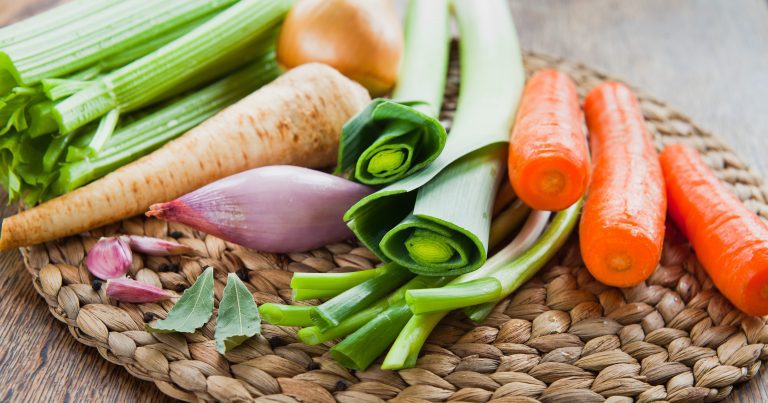The days are getting longer, the temperatures are getting warmer and some of us are feeling the urge to crack open the windows, empty the closets and sweep out the cobwebs. But what about our diets? Spring is a great time to harness some motivation to clean up our eating after a long winter of comfort foods and to build some new healthy habits. Let’s face it – most of our New Year’s resolutions are probably long gone at this point! The warmer weather also brings more fresh local produce, which makes healthy eating even more accessible.
1. Say goodbye to preservatives, and artificial colors/flavors.
Most processed or ready-to-eat foods contain preservatives or other chemical additives to extend their shelf life or make them more appealing, but there’s nothing appealing about filling your system with chemicals. Think about this… if these chemicals are added to foods to prevent them from decomposing or to add something that does not otherwise naturally occur, what affect do they have on our bodies?
When selecting packaged or processed foods, choose items with the fewest number of ingredients and ones that you can identify from whole food sources. Stay away from products with preservatives like potassium bromate (breads), nitrates/nitrites (preserved meats), sulfites (dried fruit), sodium benzoate (carbonated beverages), BHT/BHA (packaged foods) and tartrazine dye (yellow cheese) or anything that is followed by the words “to retain freshness”, “retard spoilage” or “mold inhibitor.” More “natural” food products contain natural antioxidant preservatives, such as Vitamin E (AKA tocopherol), Vitamin C (AKA ascorbic acid) and citric acid – these are naturally occurring in foods and are therefore safe to eat. If you’re worried about remembering the names of all these complex chemicals, just keep one rule in mind – the less processed the food, the less chance you’ll have to worry about chemical additives.
Check out the Environmental Working Group to learn more about the chemicals hiding in our water, food and environment.
2. Eat more fiber.
Fiber promotes a healthy gut, helps us to excrete toxins and supports weight management. By incorporating more fruits, vegetables and whole grains(including breads, pastas and cereals), you will supply your body with the soluble and insoluble fiber it needs to feed good gut bacteria, manage cholesterol, maintain consistent blood sugars and stay “regular”. If you struggle with eating enough of these foods, you can take a quality fiber supplement; however, fiber supplements won’t provide all the benefits of eating whole foods.
Keep in mind that as you incorporate more fiber you’ll need to start slow, adding a little more fiber every few days, and you’ll want to drink plenty of water to avoid some of the uncomfortable side effects that come with adjusting to a high fiber diet (nausea, bloating, gas and constipation). Women should ultimately aim for 25 grams of fiber daily and men should target 38 grams. Once you’ve adjusted to a high fiber diet, your mental health, immune system and metabolism will all benefit!
3. Eat less “added” sugar.
Added sugars are included in more than just that slice of cake or candy bar. Many products from ketchup to cereal include added sugars, which can contribute over time to weight gain, high cholesterol, poor gut health and insulin resistance (diabetes), among other things. These added sugars are not to be confused with the beneficial natural sugars found in foods like fruit, dairy and whole grains.
Added sugars are typically refined, which means they are the most simple form of carbohydrate that requires little to no digestion and travels straight into our bloodstream (hence blood sugar spikes). Read food labels carefully and be on the lookout for different added sugar ingredients such as: dextrose, fructose, sucrose, corn syrup, glucose, cane juice, maltose, molasses and trehalose. It’s also important to note the “added sugars” per serving listed on the food label and try to aim for 10% or less of total daily calories from added sugars. Some common foods that contain added sugars include: breads, bakery items, sauces, condiments, marinades, packaged snacks, cereals, granola, sweetened juices/beverages and yogurts.
4. Drink more water.
Our bodies are made up of about 60% water. It is often overlooked as a part of a healthy diet, but water is important for the proper function of all the body’s processes. Water is also major medium for excretion of waste and toxins from the body and helps prevent constipation, so staying hydrated can help us clean out our system.
Fluid needs vary by individual based on gender. age, activity level and overall health, but a good way to check your hydration status is to monitor your urine color. Pale, light yellow is a sign of adequate hydration, while dark yellow or amber colored urine may indicate that you need to drink more. Here are a few tips to help stay hydrated: keep a water bottle on hand at all times, drink water with all meals, add flavor enhancers like frozen fruit or herbs, and always opt for water over soda or energy drinks.
5. Cook at home more often.
The best way to know exactly what you’re eating is to prepare meals and snacks yourself from whole foods. Of course busy schedules and lifestyle may still warrant the occasional takeout meal or packaged snack, but the more you can food prep at home, the healthier your diet will be. Easy whole food snacks include: whole fruit (apples, oranges, pears, bananas) and all natural low fat cheese (individually wrapped portions), hummus with veggie sticks, Greek yogurt with high fiber cereal, peanut butter whole grain crackers, and homemade trail mix with nuts, seeds and dried fruit.
 For meals, utilize large batch cooking of grilled or roasted poultry/meats, hard boiled eggs, grains like rice that can be frozen into individual servings and prep large portions of washed/cut vegetables or fruit for easy assemble smoothies or salads.
For meals, utilize large batch cooking of grilled or roasted poultry/meats, hard boiled eggs, grains like rice that can be frozen into individual servings and prep large portions of washed/cut vegetables or fruit for easy assemble smoothies or salads.Take advantage of slow cookers and sheet pans for one pot/pan suppers (who doesn’t love less cleanup?!) and portion out leftovers before they go into the fridge or freezer. For seasoning or dressing, keep it simple – dried herbs, pepper, olive oil and vinegar and experiment with different flavor profiles as you get more confident.
No need to detox this year to start eating better and feeling healthier. With these few simple changes you’ll be on your way to “clean” eating before the tulips bloom!
Be well,
Nicole Ciruolo, RD, LDN
Soul Healthy Care





